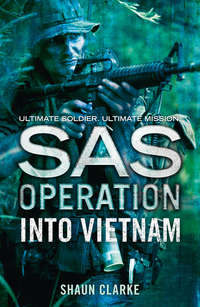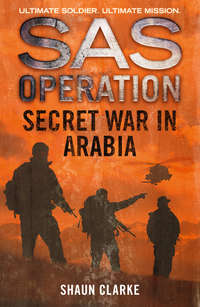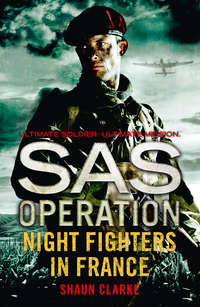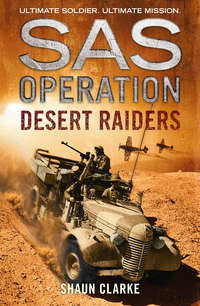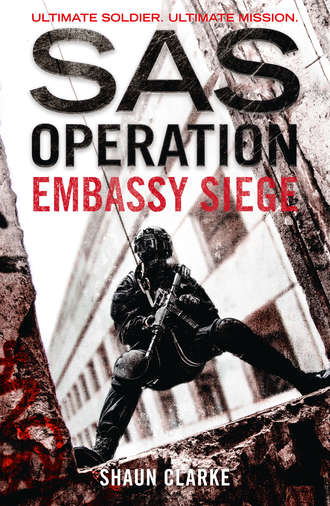
Полная версия
Embassy Siege


Embassy Siege
SHAUN CLARKE

Published by HarperCollinsPublishers Ltd
1 London Bridge Street
London SE1 9GF
www.harpercollins.co.uk
First published in Great Britain by 22 Books/Bloomsbury Publishing plc 1994
Copyright © Bloomsbury Publishing plc 1994
Cover layout design © HarperCollinsPublishers Ltd 2015
Cover photographs © Oleg Zabielin/Alamy (soldier); Shutterstock.com (textures)
Shaun Clarke asserts the moral right to be identified as the author of this work.
A catalogue copy of this book is available from the British Library.
This novel is entirely a work of fiction. The names, characters and incidents portrayed in it are the work of the author’s imagination. Any resemblance to actual persons, living or dead, events or localities is entirely coincidental.
All rights reserved under International and Pan-American Copyright Conventions. By payment of the required fees, you have been granted the non-exclusive, non-transferable right to access and read the text of this e-book on screen. No part of this text may be reproduced, transmitted, down-loaded, decompiled, reverse engineered, or stored in or introduced into any information storage and retrieval system, in any form or by any means, whether electronic or mechanical, now known or hereinafter invented, without the express written permission of HarperCollins.
Source ISBN: 9780008155124
Ebook Edition © December 2015 ISBN: 9780008155131
Version: 2015-11-02
Contents
Cover
Title Page
Copyright
Prelude
Chapter 1
Chapter 2
Chapter 3
Chapter 4
Chapter 5
Chapter 6
Chapter 7
Chapter 8
Chapter 9
Chapter 10
Chapter 11
Chapter 12
Chapter 13
Chapter 14
Chapter 15
Chapter 16
Chapter 17
OTHER TITLES IN THE SAS OPERATION SERIES
About the Publisher
Prelude
Number 16 Princes Gate formed part of a mid-Victorian terrace overlooking Hyde Park and had been used as the Iranian Embassy in London for more than a decade. Until 1979, it had represented the Iran ruled by Shah Reza Pahlavi and his wife, the Empress Fara Diba.
Noted for its Italianate stucco façade and prominent frieze, it was a very large building spread over three main floors and an attic. The ground floor comprised an imposing entrance hall, a large, beautifully furnished reception room, toilets, an administration office, and an expansive library overlooking the rear terrace. The main stairs led up to the first floor and the rather grand ambassador’s office, the more modest office of the chargé d’affaires, two administration offices and a storage room. The second floor contained two more administration offices, Rooms 9, 9A and 10, another toilet and a telex room. The third floor was the busiest, containing the press counsellor’s office, the press room, the commercial office, the xerox room, the switchboard, Room 19, the kitchen, a toilet, and two more administration rooms, one of which was empty. A well skylight with a glass roof, located between Room 19, the switchboard, the xerox room and the outer wall, overlooked the main stairs connecting the three floors. As the lift terminated on the second floor, the third floor could only be reached by the stairs.
When run by the Shah’s young and eligible Ambassador, Parvis Radji, the Embassy had been noted for its lavish dinner parties and largesse when it came to supplying excellent caviar, French wines, cars, free hotels and first-class travel to British diplomats, journalists and other visitors whose goodwill and assistance were vital to Iran. However, while ostentatiously maintaining this front of gracious, civilized living, the Embassy had also been used as a base for SAVAK, the Shah’s dreaded secret police, whose function was to spy on and intimidate London-based Iranians, mostly students. Many of these secret police were uneducated, unsophisticated and addicted to the Western ‘decadence’ they were supposed to despise: nightclubs, alcohol and bought women.
Such activities had, however, ended with the downfall of the Shah in January 1979. Six months after the revolution, the Ayatollahs replaced Parvis Radji with a new chargé d’affaires, Dr Ali Afrouz, a twenty-nine-year-old graduate in psychology and education. Once installed in the Embassy at Princes Gate, Ali weeded out the corrupt members of SAVAK, banned all alcohol from the premises, got rid of the more ostentatious luxuries of the previous regime, and in general ensured that Embassy business was conducted in a more modest, formal manner.
In the days of the Shah, the Embassy’s front door had been guarded by the British security company Securicor. Unfortunately, when Dr Afrouz took over, he dropped the company and gave the job to an Iranian, Abbas Fallahi, who had been the Embassy’s butler and knew precious little about security.
More knowledgeable in this area was Police Constable Trevor Lock, at that time a member of the Diplomatic Protection Group. This organization, being unable to give individual protection to each of London’s 138 embassies and High Commissions, was based at several strategic points in West London, remained constantly on alert in case of emergency, and also provided individual armed guards as part of the British Government’s token contribution to the embassies’ security.
Though not due to serve at the Iranian Embassy that morning, PC Lock agreed to stand in for a colleague who required the day off for personal matters. So it was that at approximately 1100 on 30 April, the policeman strapped his holstered standard-police issue .38 Smith and Wesson revolver to his thigh, carefully buttoned his tunic over the holster, then set out for the Embassy.
One of the most loyal members of the Embassy staff was not an Iranian, but an Englishman, Ron Morris, who had joined as an office boy twenty-five years before, when he was only fourteen. Ron had graduated to the position of chauffeur, then, when the luxuries of the Shah’s days were swept away, among them the ambassadorial Rolls-Royce Silver Ghost, he was made a caretaker and general maintenance man.
Just before nine o’clock on the morning of 30 April, Ron bid a routine farewell to his Italian wife Maria and cat Gingerella, left his basement flat in Chester Street, Belgravia, and drove on his moped to the Embassy, arriving there on the dot of nine. After parking his moped against the railings, he entered the building and began work as usual.
Two hours later, Simeon ‘Sim’ Harris, a thirty-three-year-old sound recordist, and Chris Cramer, a thirty-one-year-old news organizer, both with the BBC and widely experienced in the world’s trouble spots, arrived at the Embassy to try yet again – they had tried and failed before – to obtain visas to visit Iran. They were met by the doorman, Abbas Fallahi, who led them to the reception room, located through the first door on the left in the entrance hall. While waiting there, they were joined by another visitor, Ali Tabatabai, an employee of Iran’s Bank Markazi. In London for a fourteen-week course for international bankers run by the Midland Bank, Ali was visiting the Embassy to collect a film and map of Iran for a talk he was to give as part of his course. He sat beside the two BBC men and, like them, waited patiently.
These three visitors were soon joined by Majtaba Mehrnavard, an elderly, nervous man who bought and sold Persian carpets, but was there because he was worried about his health and wished to consult the Embassy’s medical adviser, Ahmed Dagdar.
Ten minutes after the arrival of the BBC team, Mustafa Karkouti, a Syrian journalist who was the European correspondent for As-Afir, the leading Beirut newspaper, arrived to interview the Embassy’s cultural attaché, Dr Abul Fazi Ezzatti. Shown into Ezzatti’s office, Room 13 on the third floor, he was offered a cup of coffee and proceeded with his interview while drinking it.
Another newsman present was Muhammad Farughi, a fifty-year-old British national born in India. He was the editor of Impact International, a Muslim magazine based in Finsbury Park, north London. Farughi had come to the Embassy for an interview with the chargé d’affaires, Dr Ali Afrouz, for an article about the Islamic revolution in Iran, and was at once escorted to the latter’s office, at the front of the building, on the first floor, overlooking Princes Gate.
On arriving at the Embassy for his day of duty on behalf of the Diplomatic Protection Group, PC Lock took up his usual position outside, by the steps leading up to the front door. On this particular morning, however, which was particularly cold, he was offered a warming cup of tea by the sympathetic doorman, Abbas Fallahi. As it would not have been proper to have been seen drinking outside the building, the frozen policeman decided to take his tea in the small ante-room between the outside door and the heavy security doors leading to the entrance hall. So he was not present outside – and, even worse, the main door was ajar – when the six armed men from Baghdad arrived at the doorstep.
Number 105 Lexham Gardens, Earls Court Road, was rather more modest than the Iranian Embassy. An end-of-terrace Victorian house with five steps leading up to the front door, it had simulated tiles on the steps and yellow awnings above the window to give the façade the appearance of a colourful Continental hotel. Inside, it was less grand. The foyer was papered with gold-flecked wallpaper, the carpet was blood-red, and an office desk served as reception.
Flat 3, on the second floor, contained three bedrooms, two sitting-rooms, two bathrooms and a kitchen. The rooms had the tired, slightly tatty appearance of all bedsits and flats in the city, with unmatching furniture, fading wallpaper, and a combination of bare floorboards and loose, well-worn carpets.
At 9.40 a.m. on Wednesday, 30 April 1980, the six Iranians who had shared the flat with another, Sami Muhammad Ali, left it one by one and gathered in the foyer. They were all wearing anoraks to keep out the cold and to conceal the weapons they would soon collect.
The leader of the group, Oan-Ali, real name Salim Towfigh, had a frizzy Afro hairstyle, a bushy beard and sideburns. Twenty-seven years old, he was the only member of the group to speak English. His second in command was twenty-one-year-old Shakir Abdullah Fadhil, also known as Jasim or Feisal, a so-called Ministry of Industry official who favoured jeans and cowboy boots and claimed to have once been tortured by SAVAK. The others were Fowzi Badavi Nejad, known as Ali, at nineteen the youngest and smallest member of the group; the short, heavily-built Shakir Sultan Said, or Shai, twenty-three and a former mechanic whose almost blond hair fell down over his ears; Makki Hounoun Ali, twenty-five, another Baghdad mechanic who now acted as the group’s humble housekeeper; and a slim young man named Ali Abdullah, known as Nejad.
Though not as obviously dominant as Oan, Ali Abdullah was greatly respected by the others because his older brother Fa’ad was one of the most important leaders of the Democratic Revolutionary Front for the Liberation of Arabistan. Fa’ad Abdullah operated in exile in Iraq and broadcast regularly for the Arabic and Farsi sections of Radio Baghdad, exhorting the Iranians to rise up against the regime of the Ayatollahs.
Ali was a serious young man. More ebullient was Makki, who informed one of the other residents that the group was heading for France. In the foyer, Ali informed the Egyptian caretaker, Ahmed, that their nine bags, weighing a total of 203lb, would be collected by David Arafat, the property agent who had rented them the flat through his Tehar Service Agency in Earls Court Road. It would then be airfreighted back to Baghdad by him. After depositing the bags with Ahmed, the group left the building.
Makki waved goodbye to those watching through the glass doors of the foyer, then blew a handful of kisses and followed the others along the pavement.
For the next hour and a half, in the steel-grey morning light, the group moved from one safe house to another, collecting an arsenal of weapons that included two deadly Skorpion W263 Polish sub-machine-guns, three Browning self-loading pistols, one .38 Astra revolver, five Soviet-made RGD5 hand-grenades, and enough ammunition for a lengthy siege. By eleven-twenty the six men were assembled in Hyde Park, near the Albert Memorial, their weapons hidden under their coats, engaged in a last-minute discussion of their plans. Just before eleven-thirty, they left the park, crossed the road, and arrived outside 16 Princes Gate. The front door of the Embassy was ajar.
After covering their faces with the loose flap of their keffias, the traditional patterned Arab headdress, so that only their eyes and noses were visible, the men removed their weapons and stormed through the open front door of the Embassy, into the entrance hall. Hearing the commotion at the outer door, PC Lock darted out of the small ante-room and was practically bowled over by the terrorists rushing in. The deafening roar of automatic fire close to his ear was followed by the sound of smashing glass. A large slice of flying glass from the inner-door panel slashed PC Lock’s cheek. Before he could remove his pistol, and as he was in the throes of sending an unfinished warning to Scotland Yard, one of the Arabs wrested the portable radio from him and another prodded his head with the barrel of a Maitraillette Vigneron M2 machine pistol. Putting up his hands, the policeman was prodded at gunpoint across the entrance hall, towards the door of reception.
Waiting there were Sim Harris, Chris Cramer, Ali Tabatabai and the highly strung Majtaba Mehrnavard, who all heard the roaring of the machine pistols, the smashing of glass and the thudding of bullets piercing the ceiling of the entrance hall. There followed frantic shouting in Arabic, then a voice bawling in Farsi: ‘Don’t move!’ Understanding the words, Ali Tabatabai wanted to go out and see what was happening, but Cramer, an experienced newsman, stopped him with a curt ‘No!’ When he and the other BBC man, Sim Harris, turned to face the wall with their hands over their heads, Ali did the same.
A few seconds later PC Lock entered the room, his hands clutching his head, his face bloody. Following him were two women who also worked in the Embassy, and following them, prodding them along with semi-automatic weapons, were more terrorists with their faces veiled in keffias.
One of the veiled terrorists, speaking in English, warned the hostages that they would be killed if they moved, then he and the other terrorists led them at gunpoint across the entrance hall and up the stairs to the second floor.
On the third floor, the journalist Mustafa Karkouti was still deeply involved in his interview with Dr Ezzatti when he heard the machine-gun fire from below. Rushing from the office, both men saw other Embassy staff rushing past, heading down the stairs. Assuming that they were heading for a fire exit, Karkouti and Ezzatti followed them, but soon found themselves in another room that had no exit at all. There were about nine people in the room, including three or four women.
To protect all those gathered in the room, the door was locked from inside. Five minutes later, however, it was kicked open and one of the terrorists entered, looking like a bandit with his keffia around his face and a pistol in one hand and a grenade in the other. After firing an intimidating shot into the ceiling, he ordered everyone to place their hands on their head and face the wall. When they had done so, another man masked with a keffia entered the room and, with the help of the first man, guided the hostages at gunpoint down the stairs to the second floor, where other Embassy staff were standing with their hands on their heads, guarded by two other masked, armed terrorists.
Ron Morris, the caretaker, was still in his office on the fourth floor. Hearing the muffled sounds of gunfire, his first thought was that a student demonstration was under way, with the police firing blank cartridges. He ran down to the first floor, where he saw PC Lock and Abbas Fallahi with their hands on their heads, being guarded by an armed Arab. Morris instantly turned around and went back up to the second floor, where he passed an accountant, Mr Moheb. On asking the accountant what was happening, he received only a blank, dazed look. The caretaker hurried up to his office on the fourth floor, planning to phone the police, but just as he was dialling 999, he heard shouting and running feet on the stairs. Not wanting to be caught with the phone in his hand, he put it down and sat behind his desk until an armed terrorist entered. Speaking in English, the terrorist ordered him to leave the room, then prodded him at gunpoint down the stairs to Room 9A on the second floor, normally occupied by the Embassy’s medical adviser, Dr Dadgar, but now filled with many hostages, all with their hands either against the wall or on their heads.
One of the gunmen searched the hostages. After frisking Morris, finding his spectacle case and throwing it to the floor, the gunman searched PC Lock, but in a manner so inept that he failed to find the policeman’s holstered pistol.
While this search was going on, other members of the Embassy staff were managing to flee the building. Zari Afkhami, who was in charge of the medical section, had her office at the rear of the ground floor. Hearing the gunshots and shouting, she opened the door, stepped into the hall, and saw a gunman prodding PC Lock in the chest with a gun. Running back into her office and closing the door behind her, she alerted an elderly clerk who had a weak heart. Afkhami opened the window and climbed out, followed by the clerk. Catching sight of two workmen at the rear of the building, she asked them to call the police.
Another official escaped by boldly climbing out onto the first-floor balcony and making his way across a parapet to the Ethiopian Embassy next door.
One who attempted to escape, but failed, was the chargé d’affaires, Dr Afrouz, who was still being interviewed by the Muslim journalist Muhammad Farughi in his office on the first floor when the attack began. Hearing gunfire and shouting, both men went to the office door, where Farughi was instantly seized by a terrorist. Afrouz managed to make it back across to the rear of his office, where he clambered out through the window. Unfortunately, in his haste he fell, spraining his wrist and bruising his face badly. Hauled back in by the terrorists, he was prodded at gunpoint into a room where there were no other prisoners. There, one of the gunmen fired a shot into the ceiling, possibly to intimidate Afrouz. He then led the limping diplomat out of the room up the stairs to the second floor, where he was placed in Room 9A with the other prisoners.
Shocked by the appearance of the injured diplomat, and assuming that he had been beaten up by one of the terrorists, Ron Morris asked one of the terrorists for some water. He bathed Afrouz’s face, then examined his jaw and confirmed that it was not broken. The chargé d’affaires, still shocked and in pain, fell asleep soon afterwards.
Informed of the attack on the Embassy, the police were already gathering outside. An officer entered the back garden, where he saw an armed Arab looking down at him from an upstairs window. Aiming his pistol at the terrorist, the police officer asked what the group wanted.
‘If you take one more step you’ll be shot,’ the Arab replied in English.
By eleven-forty-five Scotland Yard knew that one of its men, PC Lock, was one of the hostages, that he belonged to the Diplomatic Protection Group, and that he had been armed. This last fact, combined with the information that gunshots had been heard, gave them further cause for concern.
By midday, the Embassy was surrounded by police cars and vans, ambulances, reporters, press photographers, and armed policemen wearing bulletproof vests. Other police officers were on the roof of the building, clearing spectators from the balconies of the adjoining buildings. More police were across the road, opposite the Embassy, clearing people out of the park and sealing off the area.
The siege had commenced.
1
The wind was howling over the Brecon Beacons as Staff-Sergeant Bill Harrison, huddled behind a rock for protection, surveyed the vast slopes of the Pen-y-Fan to find his four-man CRW (Counter Revolutionary Warfare) team. The men, he knew, would be feeling disgruntled because the tab he was making them undergo they had all endured before, during Initial Selection and Training, with all the horrors of Sickeners One and Two. The four men now climbing the steep, rocky slope were experienced SAS troopers who had fought in Aden, Oman or Belfast, and none required a second dose of the ‘Long Drag’ or ‘Fan Dance’ across this most inhospitable of mountain ranges – or, at least, would not have done so had they been asked to do it while carrying an Ingram 9mm sub-machine-gun and a 55lb bergen rucksack.
This time, however, there was a slight but diabolical turning of the screw: they were making the same arduous tab while wearing heavy CRW body armour, including ceramic plates front and back, and while breathing through a respirator mask fixed to a ballistic helmet. In short, they were being forced to endure hell on earth.
That was only part of it. Staff-Sergeant Harrison had not only ordered them to climb to the summit of the mountain, but had then informed them that he would be giving them a thirty-minute head start, then following them to simulate pursuit by a real enemy. Thus, even as they would be fighting against exhaustion caused by the heavy body armour and murderous climb, as well as possible claustrophobia or disorientation caused by the cumbersome helmet and respirator mask, they would be compelled to concentrate on keeping out of Harrison’s sub-machine-gun sight. This would place an even greater strain on them.
In fact, they had already failed in their task. Even though wearing his own body armour and head gear to ensure that his men would not feel he was asking them to do what he could not, the tough-as-nails staff-sergeant had taken another route up the mountain – to ensure that he was unseen by his men while they were always in his sight – and circled around them to take up this position above them, just below the rocky, wind-blown summit. The men would be broken up when they found him blocking their path, emulating an enemy sniper; but that, also, was part of this lesson in endurance.
Harrison had been a member of the ‘Keeni Meeni’ assassination squads in Aden in 1966, survived the incredible SAS hike up the mighty Jebel Dhofar in Oman in 1971 and, in 1976, spent days on end in freezing observation posts in the ‘bandit country’ of south Armagh, sweating it out, waiting to ambush IRA terrorists. For this reason he knew all about endurance and insisted that his men be prepared for it.


